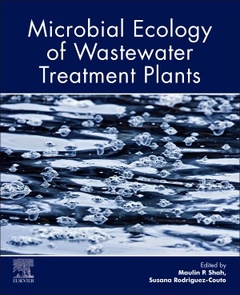Description
Microbial Ecology of Wastewater Treatment Plants
Coordinators: Shah Maulin P., Rodriguez-Couto Susana
Language: English
Subject for Microbial Ecology of Wastewater Treatment Plants:
Keywords
Aerobic; Aromatic hydrocarbon; Bioremediation; Biocatalysis; Microorganisms; Metabolism; Bioattenuation; Bioaugmentation; Biopiles; Biostimulation; Bioventing; Microbes; Phytoremediation; Chemotaxis; Culture based approach; Enzymatic remediation; ex-situ and in-situ bioremediation; Metagenomics; Bacteria; Fungi; Pesticides; Pharmaceuticals; Phase enzymes; Synthetic polymers; Aromatic compounds; Dynamic microbial; Kinetic model; Microbial consortium; Nitrification; Sequencing batch reactor; Wastewater; Environment restoration; Heavy metals; Soil; Sugar; Anaerobic; Electrochemical; Methane; Hydrogen; Activated sludge; Bioreactor; Biological oxygen demand; Pollutants; Trickling filter; Wastewater treatment; Biodegradability index; Aerobic treatment; Industrial wastewater; Biochar; Carbon sequestration; Environment; Feedstock; Pollution remediation; Antibacterial efficacy; E; coli; Silver nanoparticles; Biotechnological; Environment management; Pollutant; Tanning; Tannery industry; Contaminant; Biological; Biosensors; in-situ monitoring; Pollutant Heterogeneity
570 p. · 19x23.3 cm · Paperback
Description
/li>Contents
/li>Biography
/li>Comment
/li>
Dr. Maulin P. Shah is Chief Scientist and Head of the Industrial Waste Water Research Lab, Division of Applied and Environmental Microbiology Lab at Enviro Technology Ltd., Ankleshwar, Gujarat, India. His work focuses on the impact of industrial pollution on the microbial diversity of wastewater following cultivation-dependent and cultivation-independent analysis. His major work involves isolation, screening, identification, and genetically engineering high-impact microbes for the degradation of hazardous materials. His research interests include biological wastewater treatment, environmental microbiology, biodegradation, bioremediation, and phytoremediation of environmental pollutants from industrial wastewaters.
Susana Rodríguez-Couto (female) got her B.Sc. and M.Sc. in Chemistry (Industrial Chemistry) from the University of Santiago de Compostela in 1992 and her Ph.D. in Chemistry in 1999 from the University of Vigo, obtaining the maximal grade (magna cum laude) and, in addition, she was awarded with the Extraordinary Prize for Doctoral Thesis in Chemistry. She worked as an Associate Professor and an Isidro Parga Pondal Senior Researcher at the University of Vigo (2000-2004), as a Ramón y Cajal Senior Researcher at Rovira i Virgili University (2004-2008) and as an Ikerbasque Research Professor (2009-2019). She has also worked as an Invited Researcher at the Institute from Environmental Biotechnology, Graz University of Technology (Austria) and at the Department of Biological Engineering, University of Minho (Portugal). In 2008, she received the I3 Professor from the Spanish Ministry of Science and Education to the recognition of an outstanding research activity. In March 2021 she is joining LUT School of Engineering Science at Mikkeli, Finland, as a Full Professor in biological water treatment. She has published more than 140 articles in highly reputed international journals (h index 42). She is editor of several journals (3Biotech, Frontiers)
- Describes application of different Omics tools in Wastewater treatment plants (WWTPs)
- Demonstrates the role of microorganisms in WWTPs
- Includes discussions on the microbial ecology of WWTPs
- Covers the microbial diversity of activated sludge
- Emphasizes cutting-edge molecular tools
These books may interest you

Microbial Wastewater Treatment 179.27 €



